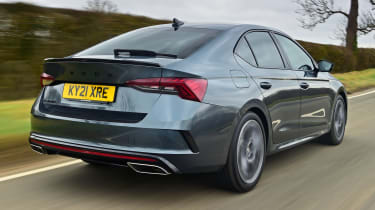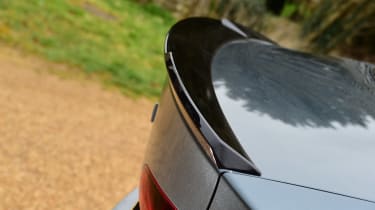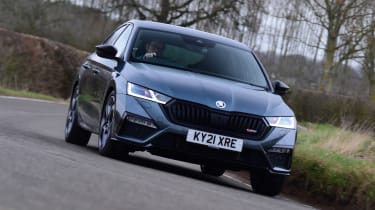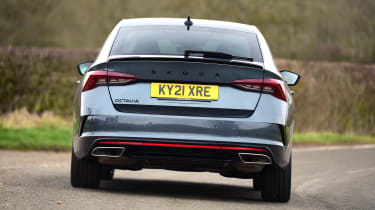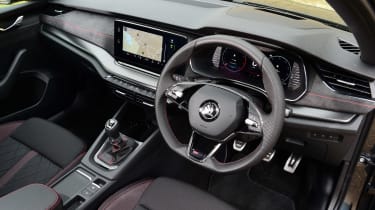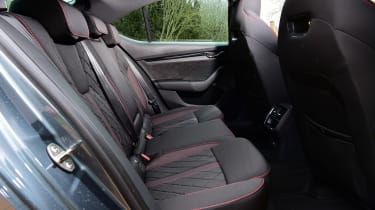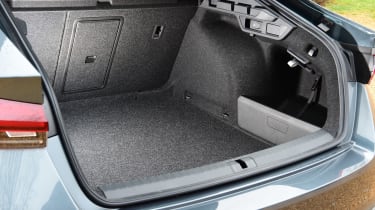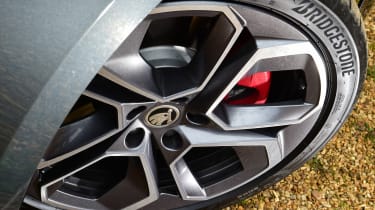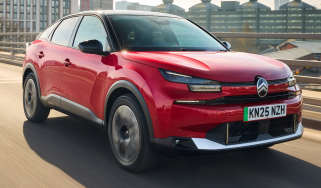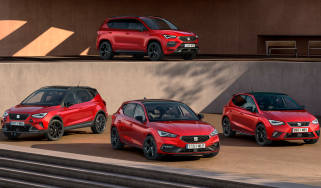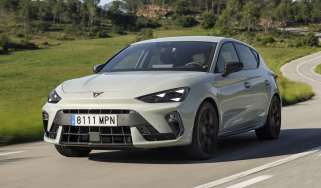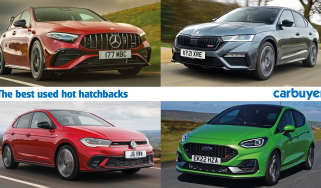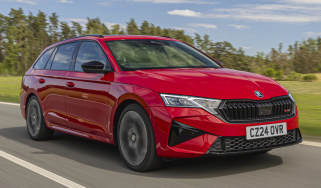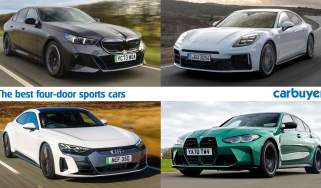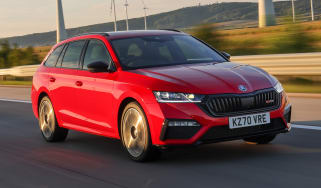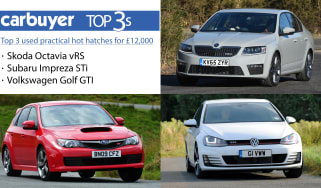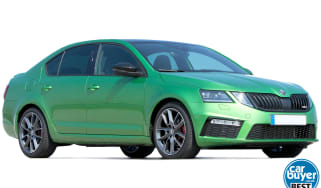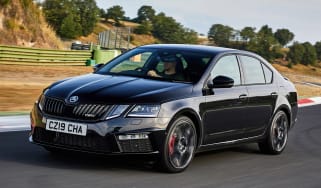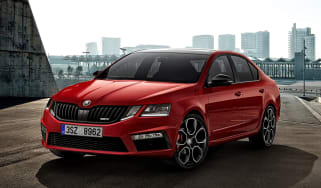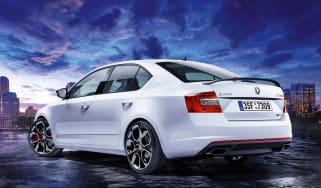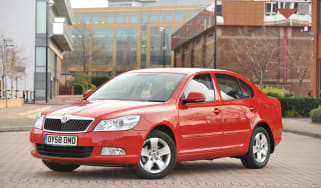Skoda Octavia vRS hatchback review
"The Skoda Octavia vRS is one of the most practical and usable hot hatchbacks around"
Pros
- Three engine choices
- Fantastic all-rounder
- Very practical
Cons
- Slightly too sensible
- Lack of steering feel
- Tyre noise
The Skoda Octavia vRS is the high-performance version of the popular family car. It’s a hot hatchback, and just like others, such as the Volkswagen Golf GTI, Hyundai i30 N and Ford Focus ST, it combines some sports-car speed with family-car practicality.
 The 10 best hot hatchbacks to buy in 2025
The 10 best hot hatchbacks to buy in 2025
The Octavia vRS is a very usable car on a daily basis. It’s not as focused on sharp handling and track-day ability as rivals like the Toyota GR Yaris or the Honda Civic Type R.
Thanks to its 600-litre boot and plentiful legroom, the Octavia vRS is really practical and spacious inside, yet it still offers plenty of performance and is fun to drive. It’s more comfortable than most hot hatches too, so it feels like an effective blend of pragmatism and pleasure.
Unlike many hot hatches, there are actually three versions of the Octavia vRS: petrol, diesel and plug-in hybrid, meaning there’s a wider range of choices to suit your lifestyle. For most, that will be the 242bhp 2.0-litre petrol (it’s the same one as in the Volkswagen Golf GTI). It’s fast and fun, especially in manual form, though the DSG automatic is decent too.
The diesel isn’t as powerful but it has lots of pulling power, so it’s only 0.8 seconds slower from 0-62mph than the petrol, at 7.4 seconds. It’s great for motorway trips as it’s far more economical at speed than the petrol model.
More reviews
There’s also a plug-in hybrid that works well for city life and short commutes. You can drive for around 39 miles on electric power only, so if you charge up every night it could be very cheap to run indeed. It uses a 1.4-litre petrol engine and produces the same 242bhp total as the purely petrol version but it’s significantly heavier, so isn’t quite as fun to drive.
It used to be the case that Skoda interiors weren't a patch on Volkswagen's but Skoda is now much closer to VW in terms of styling and finish. If anything, some people may prefer the Octavia's interior design to the more radical one found in the Mk8 Golf, which has proved somewhat polarising. There are lots of classy materials, along with the usual hot hatch touches like bucket seats, a sporty steering wheel, metal pedals and red contrasting stitching.
MPG, running costs & CO2
While the Mk1 Octavia vRS came with just a petrol turbo engine, buyers of the new hot hatchback can choose petrol or diesel power, or even opt for a plug-in hybrid (PHEV) powertrain for the first time in its history. It's an impressive offering that caters for enthusiasts (the petrol), long-distance drivers who rack up serious motorway miles (the TDI diesel) and company-car drivers looking to reduce their BiK liability, courtesy of the PHEV's low CO2 emissions.
Using its big battery and electric motor, the vRS 1.4 TSI iV can manage up to 39 miles without using any petrol. This cuts CO2 emissions to 26-27g/km, which means company-car drivers can enjoy low tax bills and a sporty car. Like any PHEV, owners will need to plug it in to reap the benefits, with a full charge from a 3.6kW wallbox taking around 3.5 hours, increasing to five hours using a standard three-pin plug. Its official fuel-efficiency figure is 235.4-256.8mpg but this will really depend on how the car is charged and driven.
The diesel engine can return up to 56.5mpg (51.4mpg if four-wheel drive is fitted), with emissions from 130-147g/km depending on the trim level. This is competitive with the Ford Focus ST diesel, which can return up to 53.3mpg.
VED (road tax) costs the standard rate for the petrol and diesel, while the PHEV gets a small discount. Insurance should be similar for each version because no matter which fuel you choose, they all sit in groups 24 or 25 out of 50 - fairly low for a hot hatch. The diesel Focus ST sits in group 23 but this rockets up to group 34 for the petrol model.
Engines, drive & performance
In hatchback guise, we've now driven the turbocharged petrol vRS, which is the top pick for driving enthusiasts. It's not set up to thrill in quite the same way as the Volkswagen Golf GTI but it’s a compelling all-round package and costs less to buy.
The 2.0-litre TSI petrol engine is as impressive as we've come to expect from the Volkswagen Group, with a smooth, linear response that serves up plenty of acceleration. Even with a manual six-speed gearbox (the DSG automatic is fractionally quicker), it can get from 0-62mph in 6.8 seconds and hit a top speed of 155mph thanks to an output of 242bhp. An even bigger surprise is that it's worth holding on to each gear beyond 4,000rpm, where some turbo engines run out of power. This smooth top end and the manual gearbox make for a fun and involving combination.
Like the majority of cars based on the VW Group's MQB architecture, the Octavia vRS has very precise steering but it doesn't offer the driver lots of feedback. Instead, you have to trust the confidence-inspiring handling, which is aided by an electronically controlled limited-slip differential - something that helps the car to deploy its power without spinning up one of the front wheels.
The optional Dynamic Chassis Control is based around a set of adaptive dampers, offering preset Comfort, Normal or Sport modes. The driver can also adjust a slider to alter the stiffness of the suspension over 15 steps, making it harder or softer as required. However, we found the default suspension setup in Sport mode plenty taut enough, especially with 19-inch alloy wheels fitted.
Pick diesel power instead and you get a 197bhp 2.0-litre turbo engine under the bonnet. It's also offered with four-wheel drive but we'd save the extra cash it costs to buy unless you live somewhere where slippery conditions are commonplace; it doesn’t make a big difference to the way the vRS drives in normal conditions. Acceleration is quicker though, thanks to the extra traction, taking 6.8 seconds instead of 7.4.
With a plug-in hybrid powertrain fitted, the vRS has an identical 242bhp to the petrol-only version, despite it being fitted with a 1.4-litre turbo petrol engine and an electric motor. Its extra weight has an effect, though, so it takes 7.0 seconds to get to 62mph from rest. If our experience in the Skoda Octavia vRS Estate is anything to go by, we also expect it to be plenty quick enough for most drivers but not as fun or involving to drive as the non-hybrid version.
Interior & comfort
If the Renault Megane RS Trophy R is at one extreme of the hot hatch scale, the Octavia vRS is at the other; it's a car people drive to work, to the shops and on holiday. For that reason, it's as refined as any other version in the range, with the only slight downside being its large wheels and low-profile tyres. There's a noticeable amount of tyre roar as a result, but even on the motorway the vRS is a comfortable car.
Its interior is just as impressive as any Octavia we've tried too, with the benefit of a sporty makeover. Gone are the light-coloured inserts of some older vRS models, replaced with two-piece bucket seats and black upholstery (including for the headlining) with contrasting red stitching. There's also some neat touches like a sports steering wheel and the use of grippy Alcantara - usually associated with high-end sports cars and racing cars.
Far from a car that’s stripped out and meant for weekend-use only, there's also a long kit list that includes Matrix LED headlights, dual-zone climate control, adaptive cruise control, heated seats and all-round parking sensors, confirming that this Skoda is better value than the Golf GTI. The infotainment setup uses a 10-inch central screen and 10.25-inch instrument dials, with vRS-themed graphics.
Like the standard car, one small niggle is that the volume and climate control are now adjusted using a touch-sensitive slider. This might be a neat design touch but in practice, trying to adjust it with one finger while driving is frustrating, and a simple dial would be more user-friendly.
Practicality & boot space
One area where the Octavia vRS has really scored in the past is as the 'practical hot hatch'. It became the fast, sporty choice for families or business drivers, who appreciated the extra space and grown-up looks of the vRS, as well as its turn of speed.
Nothing has changed for this generation; it still offers way more space than the Volkswagen Golf GTI and Cupra Leon with which it shares most of its parts, along with the Ford Focus ST. Pop its powered hatchback upwards and there's 600 litres of space behind the rear seats, which is more than some estate cars offer. With the seats folded down that increases to a wardrobe-swallowing 1,555 litres of cargo room.
There are plenty of cubbies and cup-holders to keep occupants happy on long trips, along with a decent-sized glovebox. The front door bins can hold a 1.5-litre drinks bottle, there's a rubber strap to keep items secure and a removable waste bin can even be fitted. Under the central armrest, there's Skoda's 'Jumbo Box' that's big enough to keep smart devices out of sight, and it's also ventilated with cool air when the air-conditioning is on to prevent snacks from melting.
Reliability & safety
Skoda came a respectable 12th out of 30 manufacturers in our 2021 Driver Power survey. In previous years it received high scores for build quality, infotainment and practicality. The Octavia itself also performed admirably, coming 43rd out of the top 75 cars rated.
Safety shouldn't be a concern either, thanks to a five-star score from independent crash-test body Euro NCAP. The Octavia scored an impressive 92% for adult occupant protection, with scores of 88% and 79% in the child occupant and safety assist categories respectively. Standard safety equipment includes collision avoidance assistance, lane-departure warnings and an exit warning system designed to warn passengers of oncoming traffic before they open their door.

